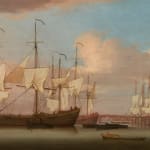Peter Monamy (London 1681-1749)
Colliers lying in the Thames at Deptford and unloading their cargoes for the London market
Oil on canvas
26 3/4 x 53 7/8 in
68 x 136.8 cm
68 x 136.8 cm
Peter Monamy was an acclaimed British marine painter of the late 17th and early 18th centuries, renowned for his evocative depictions of seascapes and naval scenes. Born in 1681 on Guernsey, one of the Channel Islands, Monamy displayed an early affinity for art, which was shaped by the maritime culture of his homeland. His works vividly capture the drama and grandeur of the sea, marking him as one of the prominent marine artists of his time.
At a young age, Monamy moved to London, where he likely apprenticed with a sign painter. His artistic skills flourished during this period, influenced by Dutch marine painters such as Willem van de Velde the Younger, whose works were popular in England. Monamy adapted their techniques to create uniquely British maritime scenes, celebrating England’s naval prowess.
By the early 18th century, Monamy had established himself as a leading painter of marine subjects. His paintings, often commissioned by naval officers and merchants, feature a dynamic interplay of light, water, and sky. These compositions showcase a mastery of detail, from the intricate rigging of ships to the turbulent movement of waves.
Monamy’s career coincided with the rise of Britain as a dominant maritime power, and his art often celebrated naval victories and exploration. His works were not only appreciated by patrons but also contributed to the growing sense of national pride in the Royal Navy.
Despite his success, Monamy struggled financially in his later years and passed away in London in 1749. His legacy, however, endures through his contributions to the genre of marine painting and his influence on subsequent artists. Today, Monamy's works are celebrated for their historical significance and artistic excellence, with examples displayed in prestigious collections such as the National Maritime Museum in Greenwich.
At a young age, Monamy moved to London, where he likely apprenticed with a sign painter. His artistic skills flourished during this period, influenced by Dutch marine painters such as Willem van de Velde the Younger, whose works were popular in England. Monamy adapted their techniques to create uniquely British maritime scenes, celebrating England’s naval prowess.
By the early 18th century, Monamy had established himself as a leading painter of marine subjects. His paintings, often commissioned by naval officers and merchants, feature a dynamic interplay of light, water, and sky. These compositions showcase a mastery of detail, from the intricate rigging of ships to the turbulent movement of waves.
Monamy’s career coincided with the rise of Britain as a dominant maritime power, and his art often celebrated naval victories and exploration. His works were not only appreciated by patrons but also contributed to the growing sense of national pride in the Royal Navy.
Despite his success, Monamy struggled financially in his later years and passed away in London in 1749. His legacy, however, endures through his contributions to the genre of marine painting and his influence on subsequent artists. Today, Monamy's works are celebrated for their historical significance and artistic excellence, with examples displayed in prestigious collections such as the National Maritime Museum in Greenwich.
Join our mailing list
* denotes required fields
We will process the personal data you have supplied in accordance with our privacy policy (available on request). You can unsubscribe or change your preferences at any time by clicking the link in our emails.



